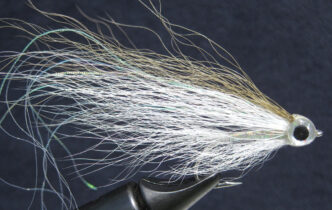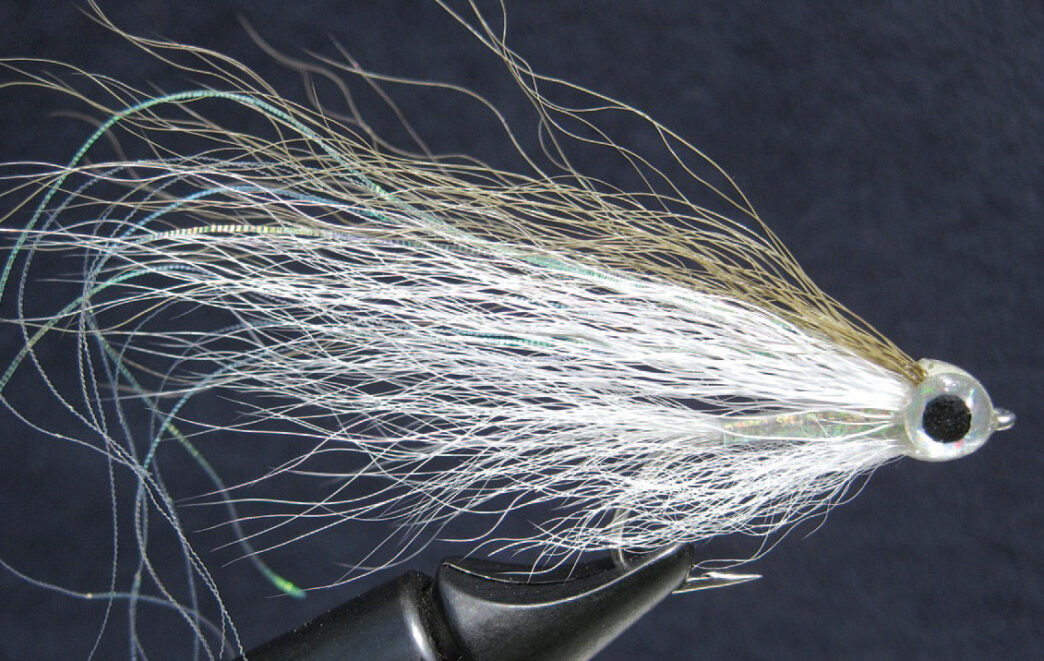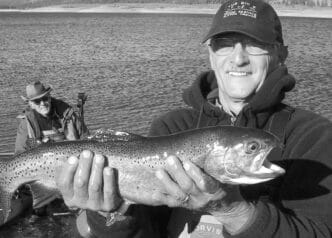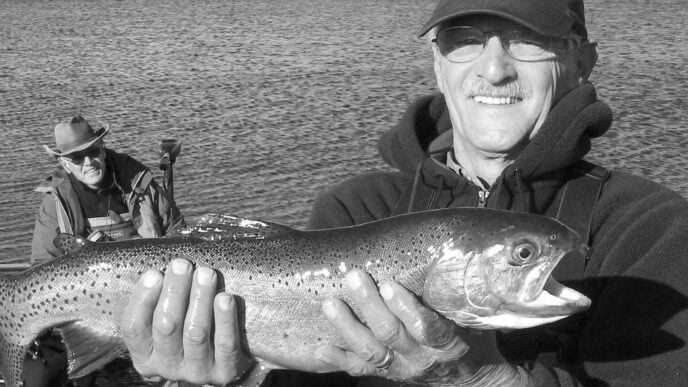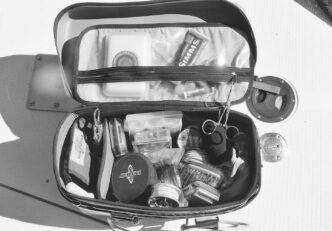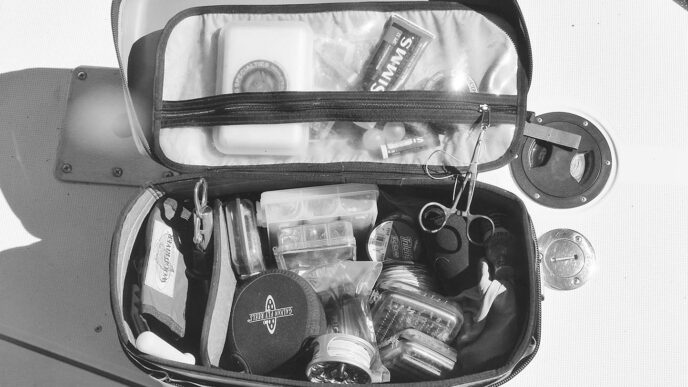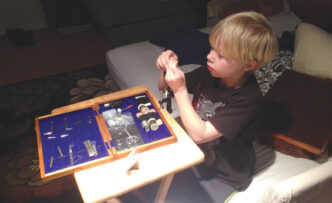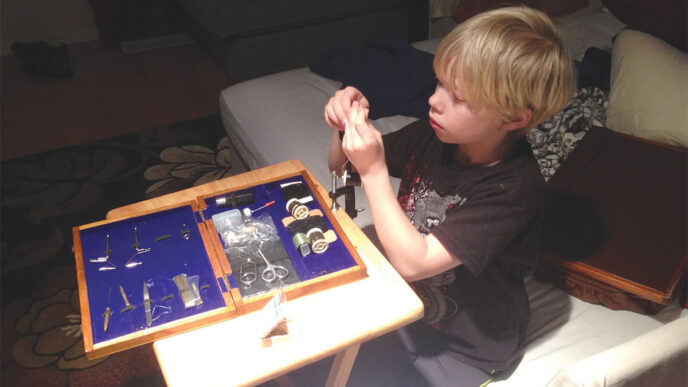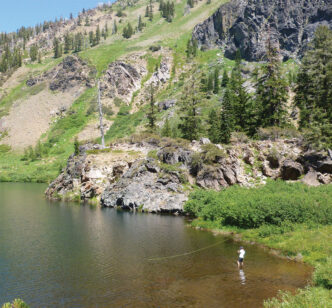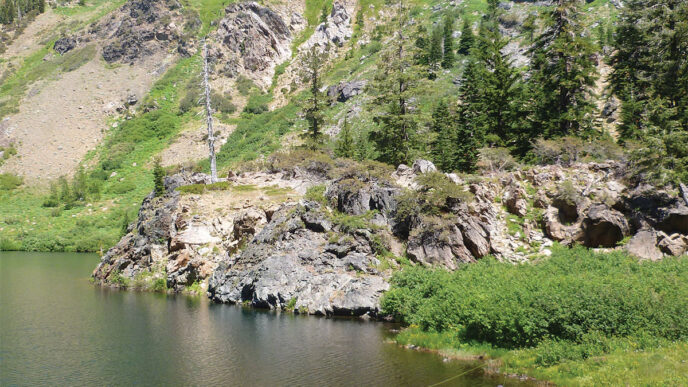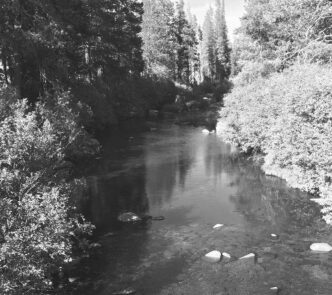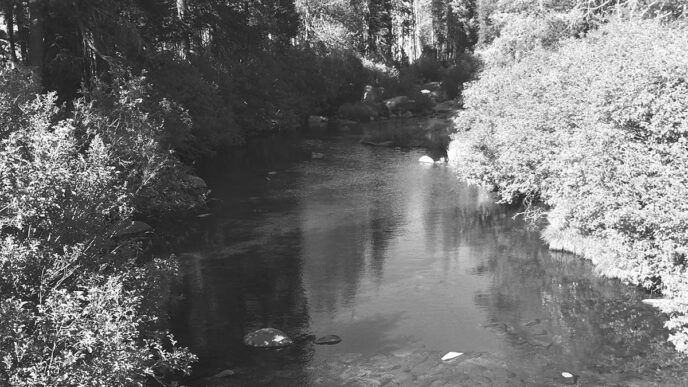Every year, an untold number of fly fishers from Southern California head up to the Sierra in pursuit of trout. You can’t blame them. The scenery is magnificent, the air is pure, and the fishing can be good, too. However, these anglers (I am one of them) pass by some of the best fishing in the state on their trek northward — and it’s not for trout. Pyramid Lake and Castaic Lake, just outside Los Angeles, harbor a prized game fish that local flyrodders rarely target: striped bass. Many northbound anglers are not aware of this resource and that fly fishing is a very effective way to take these fish, a fact that fly fishers in the San Francisco Bay and Delta areas have known for decades.
Castaic Lake, with 2,240 surface acres and 29 miles of shoreline, is located off Interstate 5 not 20 miles north of Los Angeles. And Southern California’s Pyramid Lake, consisting of 1,279 acres with 21 miles of shoreline, is about 16 miles farther up the road and eleven hundred feet higher. Both of these reservoirs are part of the State Water Project, which brings water to the Los Angeles region from the north via the California Aqueduct. The aqueduct also serves as a conduit for the striped bass.
Besides having these reservoirs nearby, another bonus for fly-fishing Angelenos is that stripers grow to be much bigger than trout and in fact reach prodigious size, in part by eating stocked trout. So without spending a good part of a day driving hundreds of miles to catch stocked trout, you can catch fish that eat stocked trout for breakfast. And besides striped bass and trout, Castaic Lake contains largemouth bass, smallmouth bass, carp, catfish, bluegills, green sunfish, and crappies. The assembly of fish in Pyramid is similar.
Striped bass are originally from the Atlantic coast. These anadromous fish were brought to the San Francisco Bay area in 1879 and have been thriving and dispersing ever since. Besides Castaic and Pyramid Lakes, there are other Southern California reservoirs that also have populations of striped bass such as Diamond Valley Lake, Silverwood, and Skinner Lake.
Stripers are prolific breeders. According to Quinn Granfors, a state fish-and-wildlife biologist, a female striper may carry one hundred thousand eggs per each pound of her weight and can be gravid anytime from the beginning of December to June. So the chances are good that some of the fry will survive to maturity. And many do, growing to enormous size. The largest striped bass on record was 125 pounds, netted in North Carolina. The top sport record for striped bass in California is 67-1/2 pounds, caught in Merced County in 1992. That is more than 40 pounds heavier than the state record for rainbow trout (27 pounds, 4 ounces) and brown trout (26 pounds, 8 ounces). The record striped bass caught at Pyramid Lake is 36 pounds — or 38 pounds, depending on your source. It’s 43 pounds for Castaic and 55-1/2 pounds for Silverwood Lake. So the chances of catching a really big fish in these waters is good.
Those are the records. It is more realistic to expect getting fish of from four to six pounds each outing. But the big fish are out there, too. You just don’t know what you might tie into with each cast — indeed, with each pull of your retrieve. It could easily be a double-digit striper. The anticipation of such an event occurring can be almost as exciting as the event itself.
Although there are different systems for fly fishing for stripers, just as there are for trout, this article focuses on those ways and gear used by Larry Kurosaki, the one and only full-time fly-fishing guide on Castaic and Pyramid Lakes. Kurosaki has been fishing these waters intensively for 35 years and has developed an effective system for taking stripers. By the way, he also holds two world records for largemouth bass on a fly, as featured in the May/June 2013 issue of California Fly Fisher.
Gear
A typical trout rod used for streamer fishing can work for striper fishing — that is, a 9-foot, fast to medium-fast 6-weight, 7-weight, or 8-weight rod. For the schoolie stripers of 4 to 6 pounds, if you are looking for a real challenge, you could get by with a 5-weight or even a 4-weight. Unless you are pitching your fly to stripers corralling a bait ball at the surface, you will generally be fishing subsurface. While a full sinking line will work, it is not ideal. You should consider using a shooting head with a skinny running line to achieve more casting distance and to sink your line faster, because the running line offers less resistance. You could use a shooting head with integrated running line or, preferably, a shooting head with mono running line. If you choose the latter, generally, you would use a 30-foot T-8 shooting head for a 7-weight rod and cut it back a foot or two for a 6-weight rod. For an 8-weight rod, you would start with 30 feet of T-11 shooting head and cut it back if necessary. The length of shooting head is dependent on the rod and how it feels when casting. Connect 200 feet of Amnesia running line to the shooting head, and to the running line, connect Dacron backing. On the front end of the shooting head, tie on a stout 9-foot leader with a 3foot 2X or 3X tippet.
Match your rod with a large-arbor reel to minimizing the coiling of the running line and for quick line retrieval. Make sure that the reel you use has a good drag, because big stripers will put it to the test. Losing the fish of a lifetime due to a poor drag will convince you of the importance of having a good one. The big striper that destroyed my old reel still haunts me.
Flies
Tried-and-true subsurface flies such as Deceivers and Clouser Minnows are viable choices, but the go-to fly for stripers at Castaic and Pyramid is Larry’s Minnow. This fly has fooled two world-record bass and was featured in the May/June 2013 issue of California Fly Fisher. It is tied by Larry Kurosaki for his and his clients’ use, but it is also available at the Fishermen’s Spot in Van Nuys. Tip: use the olive pattern in clear water and the chartreuse pattern in murky water.
Locating the Fish
Before presenting the fly, you need to locate the fish, or at least places where they are usually found. Although you can fish for stripers from shore, you would be limited, because stripers are often found in open water at these lakes, and they move around a lot. So mobility is important. You can search more areas with a watercraft. Pyramid and Castaic permit both motorized and nonmotorized watercraft and have rentals available. Float tubes are permitted on Pyramid, but prohibited on Castaic.
Striped bass are not usually found near the surface unless they are chasing shad or silversides. They tend to be deep. You will generally target stripers down to 35 feet. They are found deeper, but deeper fish are not usually worth your time, unless they are in a large pod. Striped bass tend to congregate around submerged points, ridges, and high spots. Focus on ridges that extend into the water and extrapolate the location and depth of structures in open water. Or better yet, use a USGS topographic map that displays submerged contours to locate ridges and high spots. Best of all, use a sonar device to locate not only the underwater structures, but the fish.
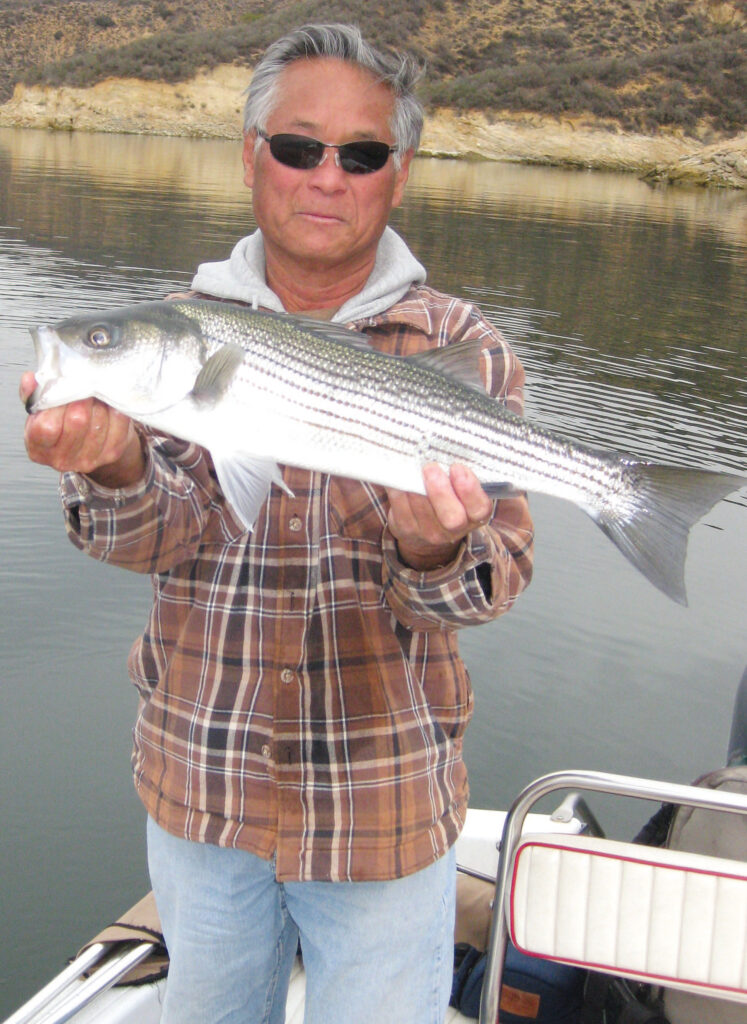
If you locate several fish, especially a pod, with a sonar device, Kurosaki suggests targeting them by throwing a marker buoy into their midst. Once the buoy is planted, you can back away and cast to the target. Without a target marking the location of the fish, every patch of water looks like every other patch of water. Without a marker buoy, you would likely be casting aimlessly and would miss the targeted fish. Cast beyond the buoy and strip the fly back near the fish or through the pod. Your sonar should tell you the depth at which the stripers are holding, so you will know how long to count down before retrieving the fly. If you do not know how deep the stripers may be, and you are casting to submerged structure, you will need to increase the countdown with each successive cast until you locate fish.
Clearly, having an idea of the depth at which the fish are holding is a great advantage. Even with a fast-sinking shooting head, typically six inches per second, it will take time to reach the fish if they are down 20 or 30 feet. This is when real patience comes into play. Larry Kurosaki sometimes uses two rods: retrieving line with one setup while the other line is sinking. This is nonstop action, and the excitement (and exhaustion) begins when you pick up a fish on every cast. This type of fishing also requires a two-rod stamp on your license. Who would have thought that one could use two fly rods at the same time?
The Cast
One of the most important elements of presentation to stripers is the long cast. Making a long cast cannot be overemphasized. It allows your fly to remain in the correct zone, where the fish are, for a long time. The longer the distance that the fly is retrieved in the zone, the more fish will have an opportunity to see it and to react. Moreover, putting the fly farther away adds an element of stealth: the fish are less likely to be aware of your presence. In addition, it is a matter of geometry: retrieving a fly after a long cast will allow it to maintain a lesser angle of ascent than with a short cast, thereby keeping the fly moving more horizontally. That being said, a strike will often occur with the sudden ascent of the fly near the end of the retrieve. This may mimic a baitfish trying to escape and may trigger a response in the fish following the fly to react. Tip: to help maintain the fly in the proper zone longer, you can stick the rod tip deep in the water during the retrieve.
How long is a long cast? Larry Kurosaki can lay out a Larry’s Minnow 120-plus feet. The minimum cast for striper fishing is about 50 feet. Casts of 75 to 90 feet would be much better. Think about it: you will need to count down the sinking fly the same amount of time whether the cast is 50 feet or 100 feet, but the longer cast will keep your Deceiver, Clouser, or Larry’s Minnow fishing for twice the time. If you cannot cast a shooting head 75 to 90 feet, you may want to work with a casting instructor or guide, then practice. Serious golfers work with a golf pro and, at the very least, hit the driving range to improve their long game. Why should it be different for avid fly fishers? Practicing your long cast will make your time on the water more productive.
The Retrieve
Once you make a long cast, you will need to let your line and fly sink down to the level of the fish. When your fly achieves the desired depth, you can commence your retrieve. It should be quick and erratic, to simulate a vulnerable baitfish. An erratic movement seems to send a message to the predator that all is not well with the prey, and the quick motion sends a message that this easy meal will soon be gone. An erratic movement is any random combination of short and long pulls, between 6 and 36 inches, with hardly a pause between the pulls. Remember: be erratic, or arrhythmic. Rhythm comes naturally to most people, but being purposely arrhythmic is difficult, albeit necessary in this case. With your rod pointed directly at your line, which is constantly tight, due to your up-tempo, staccato retrieve, you will inevitably feel the tap-tap of a hit. With a quick strip set, you will feel resistance and instantly be connected to a striped bass. If it is a large one, it will soon be rocketing toward the horizon, with your reel smoking and your adrenaline pumping.
Again, the above system is not the only system for fly fishing for striped bass, but it is a very effective method. Give it a try, but remember that even if you know what to do, doing it right is often a matter of nuance. On my first outing with Larry Kurosaki, I was experiencing a dry spell until he instructed that I increase the tempo of my retrieve. In a matter of moments . . . boom! I was fast into a striper. Later, during another dry spell, he instructed me to lengthen the long pulls of my retrieve, which I did. Before I could finished my retrieve . . . boom! I was into another striper of nearly six pounds. So if you are not having any action, tweak the technique. As the stillwater expert Denny Rickards says about retrieves, “Let the fish tell you what they like.”
The Fish
Due to the limitations of recent studies, not much is known about the stripers in these reservoirs. The California Department of Fish and Wildlife conducted a general fish study at Pyramid and Castaic Lakes in May and October of 2013. The electroshocking of randomly selected shorelines did not target stripers, because the depth was limited to 5 to 10 feet. Remember, stripers are open-water fish, and they tend to stay deep. Russell Black, the DFW environmental scientist assigned to Castaic, Pyramid, and other reservoirs in the region, says that the recent sample of stripers in Castaic (21 stripers) was too small to draw conclusions, though the fish ranged in size from 6 inches to 30 inches. The Pyramid sample was larger (60 stripers), and the fish ranged from 18 inches to 27 inches. However, the Relative Weight [to length] Index for these fish was not optimal. Further study is needed to determine the reason.
What we do know is that stripers are generally schooling fish. They form schools when young for defensive reasons. As they grow, they become more solitary or hunt in small groups, except when they form aggregations to corral baitfish, according to Quinn Granfors, a DFW reservoir biologist.
Besides being prolific breeders and growing to ponderous size, Granfors notes that stripers are aggressive predators and become piscivorous, beginning to eat other fish when only eight centimeters (just over three inches) in length. They have a tendency to proliferate at the expense of other fish, and trout are especially hit hard. For a few days after the stocking truck’s delivery, anglers swarm the shore and stripers swarm the water for the slaughter. The stripers target the trout, and the anglers target the stripers.
The largemouth bass population suffers, too. Russell Black says that striped bass reduce the largemouth bass populations by chasing away the mature bass and feeding on their young. Therefore, with all due respect to the honored catch-and-release ethic embraced by many fly fishers, it may actually help a fishery to take one or two stripers home with you. I hear they are good eating.
The Season
Fortunately stripers can be readily caught any day of the year, but the spring and fall are definitely the prime times. The fishing is good in the summer, too, but the heat can be oppressive. In the winter, the fishing falls off a little, especially at Pyramid Lake, because the water temperature falls. (Striped bass prefer water temperatures between 50 and 78 degrees Fahrenheit, with 65 degrees being near optimum.) A plus regarding winter, however, is that it is the least crowded time of the year, and the weather can be surprisingly pleasant. Hey, it’s Southern California. Last January, in the dead of winter, when the Sierra is normally under a blanket of snow, a buddy and I went out on Castaic a couple of times. The temperatures were in the 70s, and both times, we each caught and released about a dozen stripers, and I got a sunburn! Take advantage of the mild winters and good fishing.
I will continue to make the fly-fishing pilgrimage to streams up north, mostly for the grandeur of the scenery, the air scented by sage or pine, and the wild trout, where I can find them. But I know that close to home, I have an opportunity all year long to catch a lot of big fish. Perhaps it is an opportunity that you, too, might not want to pass up.



